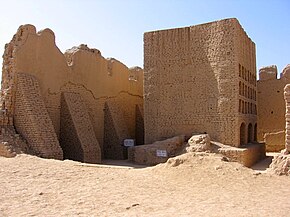Gaochang
| قۇچۇ 高昌 |
|

|
|
| Location | Xinjiang, China |
|---|---|
| Coordinates | 42°51′10″N 89°31′45″E / 42.85278°N 89.52917°ECoordinates: 42°51′10″N 89°31′45″E / 42.85278°N 89.52917°E |
| Type | Settlement |
| Site notes | |
| Condition | In ruins |
Gaochang (Chinese: ; pinyin: ; Old Uyghur: قۇچۇ, Qocho), also called Karakhoja, Qara-hoja, Kara-Khoja, or Karahoja (قاراغوجا in Uyghur), is the site of a ruined, ancient oasis city on the northern rim of the inhospitable Taklamakan Desert in present-day Xinjiang, China. The site is also known in published reports as Chotscho, Khocho, Qocho, or Qočo. During the Yuan and Ming dynasties, Gaochang was referred to as "Halahezhuo" () (Qara-khoja) and Huozhou.
The ruins are located 30 km southeast of modern Turpan. The archaeological remains are just outside the modern town of Gaochang, at a place called Idykut-schari or Idikutschari by local residents. (see the work of Albert Grünwedel in the external links below). Artistic depictions of the city have been published by Albert von Le Coq. Gaochang is considered in some sources to have been a "Chinese colony", that is, it was located in a region otherwise occupied at the time by West Eurasian peoples.
A busy trading center, it was a stopping point for merchant traders traveling on the Silk Road. It was destroyed in wars during the 14th century, and old palace ruins and inside and outside cities can still be seen today.
Near Gaochang is another major archeological site: the Astana tombs.
The earliest people known to have lived in the area were the Gushi (or Jushi). The region around Turfan was described during the Han dynasty (206 BCE – 220 CE) as being occupied by the Jūshī, while control over the region swayed between the Han-Chinese and the Xiongnu.
...
Wikipedia

